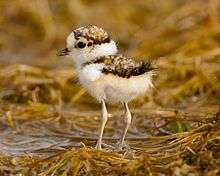Charadrius
Charadrius is a genus of plovers, a group of wading birds. The genus name Charadrius is a Late Latin word for a yellowish bird mentioned in the fourth-century Vulgate. The name derives from Ancient Greek kharadrios, a bird found in river valleys (from kharadra, "ravine"). Some believed that seeing it cured jaundice.[1]
| Charadrius | |
|---|---|
 | |
| Killdeer (Charadrius vociferus) | |
| Scientific classification | |
| Kingdom: | Animalia |
| Phylum: | Chordata |
| Class: | Aves |
| Order: | Charadriiformes |
| Family: | Charadriidae |
| Subfamily: | Charadriinae |
| Genus: | Charadrius Linnaeus, 1758 |
| Type species | |
| Charadrius hiaticula Linnaeus, 1758 | |
| Species | |
|
See text | |
| Synonyms | |
|
Aegialites / Aegialitis | |
They are found throughout the world.
Many Charadrius species are characterised by breast bands or collars. These can be (in the adult) complete bands (ringed, semipalmated, little ringed, long-billed), double or triple bands (killdeer, three-banded, Forbes', two-banded, double-banded) or partial collars (Kentish, piping, snowy, Malaysian, Javan, red-capped, puna).
They have relatively short bills and feed mainly on insects, worms or other invertebrates, depending on habitat, which are obtained by a run-and-pause technique, rather than the steady probing of some other wader groups. They hunt by sight, rather than by feel as do longer-billed waders like snipe.
Species of the genus Aegialites (or Aegialitis) are now subsumed within Charadrius.
Species in taxonomic order
- New Zealand dotterel, red-breasted plover or New Zealand plover, Charadrius obscurus
- Common ringed plover, Charadrius hiaticula
- Semipalmated plover, Charadrius semipalmatus
- Long-billed plover, Charadrius placidus
- Little ringed plover, Charadrius dubius
- Wilson's plover, Charadrius wilsonia
- Killdeer, Charadrius vociferus
- Piping plover, Charadrius melodus
- Madagascan plover, Charadrius thoracicus
- Kittlitz's plover, Charadrius pecuarius
- Saint Helena plover, Charadrius sanctaehelenae
- Three-banded plover, Charadrius tricollaris
- Forbes's plover, Charadrius forbesi
- Kentish plover, Charadrius alexandrinus
- White-faced plover, Charadrius dealbatus
- Snowy plover, Charadrius nivosus
- Javan plover, Charadrius javanicus
- White-fronted plover, Charadrius marginatus
- Red-capped plover, Charadrius ruficapillus
- Malaysian plover, Charadrius peronii
- Chestnut-banded plover, Charadrius pallidus
- Collared plover, Charadrius collaris
- Puna plover, Charadrius alticola
- Double-banded plover or banded dotterel (New Zealand), Charadrius bicinctus
- Two-banded plover, Charadrius falklandicus
- Lesser sand plover, Charadrius mongolus
- Greater sand plover, Charadrius leschenaultii
- Caspian plover, Charadrius asiaticus
- Oriental plover, Charadrius veredus
- Eurasian dotterel, Charadrius morinellus
- Rufous-chested plover, Charadrius modestus
- Mountain plover, Charadrius montanus
Gallery
 Kentish plover (C. alexandrinus)
Kentish plover (C. alexandrinus) Semipalmated plover (C. semipalmatus)
Semipalmated plover (C. semipalmatus)_right_in_the_middle_of_the_S59_Road_(11926451373).jpg) Three-banded plover (C. tricollaris) eggs on open ground
Three-banded plover (C. tricollaris) eggs on open ground Little ringed plover (C. dubius) chick
Little ringed plover (C. dubius) chick
References
- Jobling, James A (2010). The Helm Dictionary of Scientific Bird Names. London: Christopher Helm. p. 99. ISBN 978-1-4081-2501-4.
| Wikimedia Commons has media related to Charadrius. |